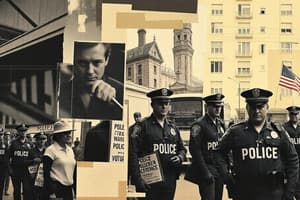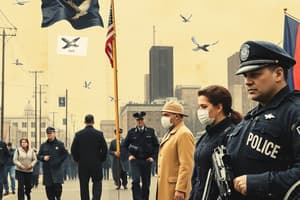Podcast
Questions and Answers
What is a core principle of the Broken Windows Theory?
What is a core principle of the Broken Windows Theory?
- Crime is primarily caused by individual moral failings.
- Strong community bonds are sufficient to prevent crime.
- Visible signs of disorder can lead to more serious crime. (correct)
- Police presence is the only effective deterrent to crime.
Which of the following best describes a consequence of neglecting minor offenses according to the Broken Windows Theory?
Which of the following best describes a consequence of neglecting minor offenses according to the Broken Windows Theory?
- It communicates a lack of community care and order, increasing serious crime. (correct)
- It has no impact on the overall crime rate.
- It leads to a more efficient and effective justice system.
- It encourages greater investment in community programs.
What does the Social Disorganization Theory primarily attribute the causes of crime to?
What does the Social Disorganization Theory primarily attribute the causes of crime to?
- The characteristics of a community. (correct)
- Insufficient police intervention.
- Individual genetic predispositions.
- Lack of social programs.
According to the Social Disorganization Theory, which factor influences crime rates the most?
According to the Social Disorganization Theory, which factor influences crime rates the most?
Which approach aligns most closely with the principles of the Broken Windows Theory?
Which approach aligns most closely with the principles of the Broken Windows Theory?
How does the Social Disorganization Theory differ from the Broken Windows Theory?
How does the Social Disorganization Theory differ from the Broken Windows Theory?
What is the most effective strategy to combat crime based on the Broken Windows Theory?
What is the most effective strategy to combat crime based on the Broken Windows Theory?
According to the Social Disorganization Theory, what is a characteristic of communities with high crime rates?
According to the Social Disorganization Theory, what is a characteristic of communities with high crime rates?
What is the main argument of the Social Disorganization Theory regarding where crime originates?
What is the main argument of the Social Disorganization Theory regarding where crime originates?
Which of the following illustrates a practical application of the Broken Windows Theory?
Which of the following illustrates a practical application of the Broken Windows Theory?
What is a core tenet of social disorganization theory?
What is a core tenet of social disorganization theory?
Which of the following is seen as a factor contributing to crime according to social disorganization theory?
Which of the following is seen as a factor contributing to crime according to social disorganization theory?
How does social disorganization theory explain the variation in crime rates across different areas?
How does social disorganization theory explain the variation in crime rates across different areas?
What potential critique is identified when considering social disorganization theory?
What potential critique is identified when considering social disorganization theory?
According to social disorganization theory, what is the effect of weakened social capital on a community?
According to social disorganization theory, what is the effect of weakened social capital on a community?
Which of the following is NOT a direct element of social disorganization?
Which of the following is NOT a direct element of social disorganization?
What does social disorganization theory suggest about the relationship between community strength and crime?
What does social disorganization theory suggest about the relationship between community strength and crime?
What is a significant aspect of neighborhoods that often experience disorganization?
What is a significant aspect of neighborhoods that often experience disorganization?
How does residential instability contribute to social disorganization?
How does residential instability contribute to social disorganization?
Which factor is LEAST likely to contribute to social disorganization according to the content?
Which factor is LEAST likely to contribute to social disorganization according to the content?
Flashcards
Community Oriented Policing (COP)
Community Oriented Policing (COP)
A strategy emphasizing partnerships between police and community to address crime proactively.
Proactive Problem-Solving
Proactive Problem-Solving
Addressing issues before they escalate, focusing on community needs and concerns.
Building Trust
Building Trust
Establishing reliable communication and relationships between police and residents.
Neighborhood Watch Programs
Neighborhood Watch Programs
Signup and view all the flashcards
Problem-Oriented Policing (POP)
Problem-Oriented Policing (POP)
Signup and view all the flashcards
Scanning, Analysis, Response, Assessment
Scanning, Analysis, Response, Assessment
Signup and view all the flashcards
Broken Windows Theory
Broken Windows Theory
Signup and view all the flashcards
Visible Signs of Disorder
Visible Signs of Disorder
Signup and view all the flashcards
Social Disorganization Theory
Social Disorganization Theory
Signup and view all the flashcards
Collaboration in Problem Solving
Collaboration in Problem Solving
Signup and view all the flashcards
Factors Contributing to Crime
Factors Contributing to Crime
Signup and view all the flashcards
Neighborhood Characteristics
Neighborhood Characteristics
Signup and view all the flashcards
Community Cohesion
Community Cohesion
Signup and view all the flashcards
Social Capital
Social Capital
Signup and view all the flashcards
Weak Community Institutions
Weak Community Institutions
Signup and view all the flashcards
Crime Rate Variations
Crime Rate Variations
Signup and view all the flashcards
Residential Instability
Residential Instability
Signup and view all the flashcards
Social Control
Social Control
Signup and view all the flashcards
Critique of Social Disorganization Theory
Critique of Social Disorganization Theory
Signup and view all the flashcards
Study Notes
Community Oriented Policing (COP)
- Emphasizes partnerships between the police and the community to address crime and disorder.
- Focuses on proactive problem-solving and community engagement.
- Involves building trust and communication through regular interaction with residents.
- Strategies include: community meetings, neighborhood watch programs, and citizen patrols.
- Aims to reduce crime rates through increased community vigilance and cooperation.
- COP often looks beyond just reactive policing to include a comprehensive understanding of the community needs, priorities, and concerns.
- COP can be effective when accompanied by a deeper understanding of underlying causes of crime problems in the targeted communities.
- May take longer to see impact due to the need for building long-term relationships and trust.
Problem-Oriented Policing (POP)
- A proactive approach that identifies and addresses underlying problems, not just incidents.
- Focuses on understanding the causes of problems that lead to crime and disorder.
- It systematically analyzes problems, develops solutions, and implements strategies.
- Steps involved: Scanning, Analysis, Response, Assessment.
- Aims to prevent future occurrences of similar events through carefully developed solutions.
- Involves collaboration between police, citizens, and other stakeholders to solve problems.
- Helps identify recurring patterns or trends in crime and disorder, allowing for targeted intervention and solution development.
- May involve community resources beyond traditional law enforcement.
Broken Windows Theory
- Developed by Wilson and Kelling.
- Suggests that visible signs of disorder and crime create an environment conducive to further crime.
- Focuses on the idea that unchecked minor crimes and acts of vandalism signal a lack of community care and order.
- This fosters an environment conducive to more serious crimes.
- Implies that maintaining order and addressing minor infractions can decrease more serious crime.
- Addresses visible signs of disorder like graffiti, vandalism, and public intoxication.
- This theory suggests a strong impact of visible disorder cues on perceptions of safety and order, which in turn can influence crime rates.
Social Disorganization Theory
- Suggests that crime and other social problems are linked to characteristics of a community, not individual offenders.
- Identifies factors like poverty, lack of social cohesion, residential instability, and weak social controls as contributing to crime.
- Focuses on the social and environmental factors within particular neighborhoods that could cause dysfunction and thus crime.
- Explains that weakening community institutions and social capital can lead to increased crime rates.
- Implies a link between neighborhood structure and crime rates.
- Areas with these characteristics often lack the resources to effectively address problems and prevent crime.
- The theory suggests that a strong sense of social organization and control within a community is important for reducing crime.
- Critiques include potential for labeling and targeting specific neighborhoods, potentially exacerbating inequalities.
- Provides a framework for understanding why there are variations in crime rates across different geographical areas.
Studying That Suits You
Use AI to generate personalized quizzes and flashcards to suit your learning preferences.




